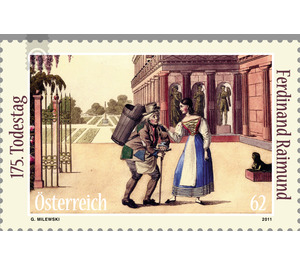175th anniversary of death - Austria / II. Republic of Austria 2011 - 62 Euro Cent
Theme: Art & Culture
| Country | Austria / II. Republic of Austria |
| Issue Date | 2011 |
| Face Value | 62.00 |
| Edition Issued | 320,000 |
| Printing Type | offset |
| Stamp Type | Commemorative |
| Item Type | Stamp |
| Chronological Issue Number | 2285 |
| Chronological Chapter | OOS-OE2 |
| SID | 887182 |
| In 55 Wishlists | |
On the 5th of September, the fiftieth anniversary of Ferdinand Raimund's death will mark the 175th anniversary of the publication of the present special stamp, with which the famous Austrian dramatist will be honored. Together with Johann Nestroy, Raimund is undoubtedly one of the most important representatives of the Alt-Wiener Volkstheater. Ferdinand Raimund, born on June 1, 1790 in Vienna, was the son of an immigrant Bohemian master wood turner. As a young confectionery salesman in the theater, he first came into contact with the profession of acting; Soon after, he joined roving comedians and went on tour with them through the province. After initial failures, he eventually moved with several acting troops through Western Hungary for several years. In 1814 he returned to Vienna and celebrated his first successes at the Theater in der Josefstadt. His artistic breakthrough came in 1815 with the play "Die Musikanten am Hohen Markt", written by his future father-in-law Josef Alois Gleich. From 1817 Raimund belonged to the ensemble of the theater in the Leopoldstadt, two years of it, 1828 to 1830, even the directorate. Here he not only played but also directed. An unfortunate marriage, numerous affairs and his idea of ideal love characterized his work as a writer as well as his hypochondria and his enormous ambition to actually be born a "tragedian". Despite his goal, the tragic character subject, however, he achieved his greatest success with pieces from the field of comedy - both in the criticism and the audience. Plagued by depression and withdrawn to his villa in Pernitz (Lower Austria), Ferdinand Raimund died at the age of only 46 years. He is buried in the mountain cemetery to Gutenstein. The influence of his literary work on the further development of the popular play and drama in the 20th century is undisputed. In his work, the traditions of the Baroque theater, the Stegreifspiels and the Viennese magical piece as well as those of the local idiom, the parody and the bourgeois drama resulted. "The farmer as a millionaire", "The Alpine King and the misanthrope" and "The spendthrift" (with the famous "Hobellied") are still among the most popular and most played plays in the German-speaking world.


